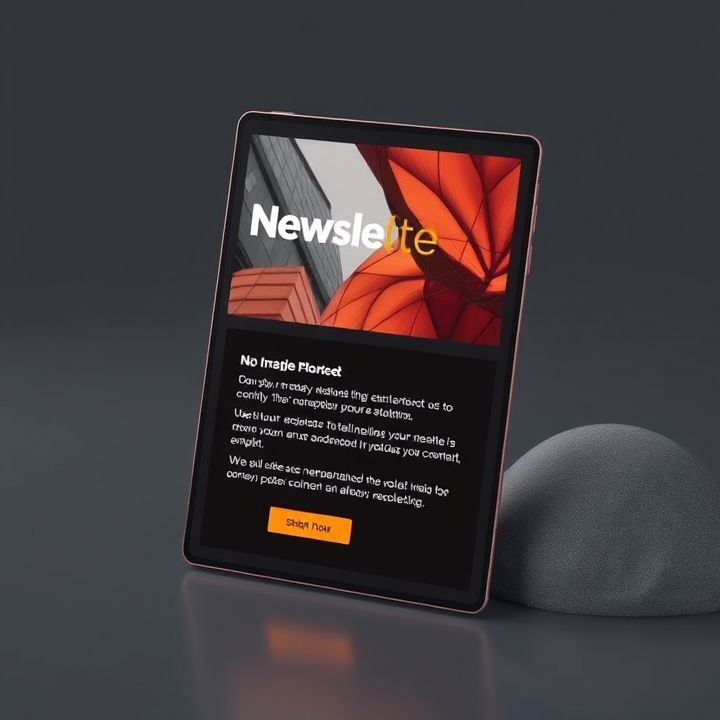Table of Contents
- Introduction
- Choosing high-quality and relevant images
- Using images to reinforce your message and brand
- Ensuring optimal image size and resolution for fast loading
- Incorporating multimedia elements for engagement
- Personalizing images and media for your audience
- Conclusion
- Frequently Asked Questions
Introduction
In today’s digital age, email remains a cornerstone of effective marketing strategies, offering a direct line to engaged audiences around the globe. Yet, with inboxes flooded with countless messages daily, how can a marketer ensure their emails not only stand out but also captivate their audience? The answer lies in mastering the use of images and media. With the right blend of visual elements, you can transform a mundane email into an appealing piece that demands attention.
Explore the profound impact images can have on your email campaigns as we delve into techniques that can take your engagement rates from flat to soaring heights. But before we dive in, let’s examine some compelling statistics on why visuals matter.
| Impact of Visuals | Email Engagement |
|---|---|
| Emails with images | 42% higher click-through rate |
| Using videos in emails | Increase conversions by 80% |
Stay with us as we unveil how mastering the art of images and media can revolutionize your email marketing approach.
Choosing high-quality and relevant images
When optimizing emails with visual elements, selecting high-quality and relevant images is crucial for capturing the attention of your audience. Ensure the images you choose are clear and of high resolution, so they appear professional and don’t detract from your message. Be mindful of image size, as large files can slow down load times, potentially causing recipients to lose interest before the email fully loads. Aim for a balance between quality and file size by using formats like JPEG or PNG, which offer compression without significant loss of clarity.
Relevance is equally important in your selection process; images should align with the content and call-to-action of your email. Consider the purpose of your message and the audience you are targeting. Whether it’s a product showcase or a service being advertised, the visuals should complement and enhance the narrative behind your text. Additionally, avoid using overly generic stock photos that may seem unoriginal. Instead, opt for unique and personalized visuals that captivate and resonate with your audience, enhancing both engagement and conversion rates. When used thoughtfully, images not only break up text but also create a more engaging and visually appealing email experience for your readers.
Using images to reinforce your message and brand
Images play a crucial role in reinforcing your message and brand within emails. When chosen and utilized effectively, they can do much more than simply break up text; they can emphasize key points, evoke emotions, and create a memorable visual identity that resonates with your audience. To maximize the impact, select images that are closely aligned with your brand’s aesthetic and message. Cohesive visuals ensure that your brand is instantly recognizable, whether the images depict products, services, or thematic elements related to your brand’s identity.
Moreover, consider the use of high-quality, professional images as they convey trust and credibility. Personalized images can increase engagement by making the content more relatable to the recipients. Additionally, including images with alt text ensures accessibility, allowing visually impaired users to understand the visual content through descriptive language. This not only broadens your reach, but also enhances user experience.
Lastly, the strategic placement of images is key. Position them in a way that naturally guides the reader’s eye through the email, highlighting important information and calls to action. By thoughtfully integrating images, you can create a more compelling and impactful email campaign that reinforces your brand’s message.
Ensuring optimal image size and resolution for fast loading
Ensuring optimal image size and resolution is crucial for fast loading and improved user experience in emails. Large image files can slow down email loading times, leading to decreased engagement rates. To achieve this, always resize images to the exact dimensions needed in the email layout before uploading them. This not only reduces the file size but also ensures that the images are displayed crisply without stretching or distorting. It’s advisable to use image formats like JPEG for photographs, which provide good quality at smaller file sizes, and PNG for graphics or images requiring transparency.
Another aspect of optimization is maintaining an appropriate resolution. While higher resolutions offer greater detail, they also contribute to larger file sizes. A resolution of 72 DPI (dots per inch) is generally recommended for digital formats, as it balances clarity and performance. Additionally, consider using compression tools to further minimize file size without compromising quality. Tools like TinyPNG or JPEGmini can automatically adjust compression levels to provide the smallest possible file size while maintaining visual integrity. By focusing on the precise size and resolution of images, you ensure your emails not only load quickly but also convey a professional and polished appearance.
Incorporating multimedia elements for engagement
Incorporating multimedia elements into your email marketing strategies can significantly enhance user engagement and improve overall communication effectiveness. By strategically using images, videos, GIFs, and other multimedia, you can capture the reader’s attention and convey your message more dynamically. For instance, images should be high-quality but optimized for fast loading, ensuring they do not detract from the email’s overall performance. Using alt text for images is also crucial as it ensures accessibility and aids in search engine optimization.
Videos can be a game-changer for emails, making complex information easier to digest. Embedding short videos or including a video thumbnail linked to a hosted platform can elevate user experience, although technical limitations mean embedding directly into emails is often not feasible.
Furthermore, interactive elements like GIFs and animations can add a lively touch to emails, drawing the eye to key calls-to-action or highlighting important points without overwhelming the user. However, it’s necessary to maintain a balance, ensuring that these elements complement rather than clutter the overall content. Finally, tracking multimedia engagement metrics can offer invaluable insights into what works best for your audience, guiding future email campaigns towards success.
Personalizing images and media for your audience
Personalizing images and media in your emails is a powerful strategy to engage your audience more effectively. By tailoring content to meet the preferences and interests of your recipients, you can create a more immersive and relevant experience. One approach is to use dynamic content, which changes the image or media based on the recipient’s past behavior or demographics. This could mean showcasing products they’ve previously browsed or adding their first name to an image.
Utilizing audience segmentation can also enhance personalization. By categorizing your audience into distinct groups based on various criteria such as location, age, or purchasing habits, you can tailor your media content more precisely. For instance, feature images that resonate with local culture or trends in a particular region.
Moreover, testing different media types and placements can further optimize personalization efforts. A/B testing can help determine which type of media or content arrangement garners the most engagement from your audience. This data-driven approach ensures that you are consistently tweaking your strategies to maximize impact. In conclusion, by understanding and leveraging personalized images and media elements tailored to your audience’s unique preferences, you can significantly enhance engagement and build a stronger connection with your subscribers.
Conclusion
In conclusion, mastering the art of using images and media in email marketing opens the door to unparalleled engagement opportunities. By carefully selecting high-quality, relevant visuals and optimizing them for fast load times, you not only enhance the aesthetic appeal of your emails but also strengthen your brand message. Integrating multimedia elements such as videos and GIFs can captivate audiences, while personalized content resonates more deeply with your recipients, leading to improved communication and higher conversion rates. Furthermore, strategically placed visuals, alongside relevant alt text for accessibility, ensure your message reaches a broader audience effectively. Continuously testing and analyzing multimedia strategies allows for fine-tuning that maximizes engagement tailored to your audience’s unique preferences. By prioritizing these aspects, your email campaigns not only become visually engaging but also drive meaningful interactions, propelling your brand’s success in an increasingly competitive digital landscape.

